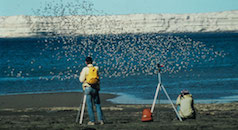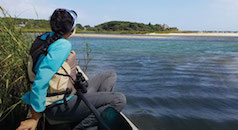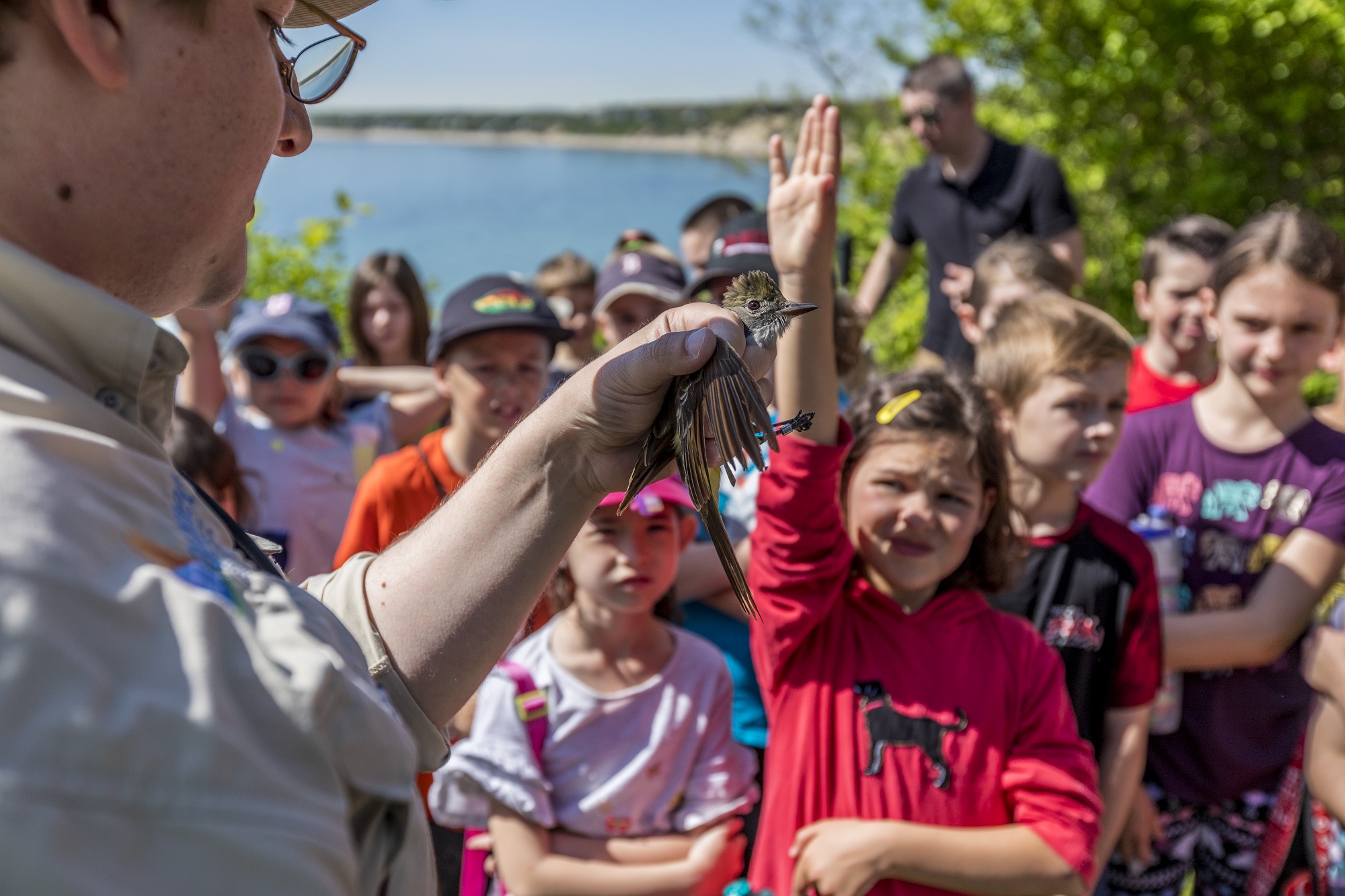Search Results

Coats Island Researchers Check Whimbrel Stopover Point
Before Manomet researchers left Coats Island in Hudson Bay this summer, the team examined a nearby site that was recently discovered as a possible staging location for Whimbrels during their migration from the Arctic to South America. Manomet’s Brad Winn has worked with the Georgia Department of Natural Resources and the Center for Conservation Biology over the past few years to put satellite transmitters on Whimbrels. Winn and the partner organizations observed that one of the birds stopped on Coats Island in two different years after nesting in Canada’s Northwest Territories. The bird spent about a month on the island before undertaking a 4,000-mile journey over the Atlantic Ocean to the north coast of Brazil. “We knew...
Arctic Research Expeditions Finish with a Rare Sight
As the short Arctic summer draws to a close and Manomet’s researchers finish their expeditions, the team at the Canning River Delta on the north slope of Alaska has made a rare find – a Semipalmated Sandpiper that was previously banded by New Jersey Audubon in Brazil. Considering that just over a thousand of these tiny shorebirds are banded in Brazil each year out of a total global population of 2.25 million, the probability of the Canning team seeing one are about one in 1,800, according to researcher Ian Davies. “The odds are definitely stacked against us, but apparently not too severely to stop us from seeing one,” he wrote in a recent blog post. Even more...
Presentation in Bar Harbor on Restoring Downeast Maine’s Fisheries
With sharp declines in fish populations and severe federal restrictions on allowable catch, the New England fishing industry is in dire straits. Last month, the Boston Globe reported that the number of federally licensed groundfishing boats in the Northeast had fallen from 1,019 to 344 between 2001 and 2011. On July 30th Manomet will hold an event in Bar Harbor, Maine, to introduce the Downeast Fisheries Partnership, a regional partnership focused on restoring healthy fisheries and fishing communities in Downeast Maine. In eastern Maine the fishing industry is crucially important, according to Manomet’s Anne Hayden. Manomet is working with two other Maine nonprofits, the Penobscot East Resource Center and the Downeast Salmon Federation. “Fishing is responsible for feeding...
Arctic Research Teams Race to Tag Semipalmated Sandpipers
Manomet researchers on Coats Island in Canada's Hudson Bay have tagged 19 Semipalmated Sandpipers with geolocators, more than half of the 36 they brought for the expedition. Coats Island, the largest uninhabited island south of the Arctic Circle in the Western Hemisphere, is one of two locations where Manomet researchers are camped: the other is by the Canning River Delta on the northern coast of Alaska. Both sites are part of the Arctic Shorebird Demographics Network (ASDN), an international collaboration to determine the causes behind declining populations of shorebirds. The project is led by Manomet, the U.S. Fish and Wildlife Service and Kansas State University. The Semipalmated Sandpiper is a small shorebird that the teams at Canning...
Shorebird Research Team Departs for the Arctic
A four-person Manomet team left this week for Coats Island, a remote sub-Arctic island in Canada’s Hudson Bay, to study troubling developments in Semipalmated Sandpiper populations. This small, migrant shorebird is one of the most common species in the Arctic and spends its winters in northeast South America. “There has been about an 80 percent decline in the population of this bird in its core wintering areas according to surveys by the New Jersey Audubon Society, without a correspondent decline, as far as we can tell, in its Arctic populations,” said Stephen Brown, director of Manomet’s Shorebird Science Division. “We don’t know if the species is declining rangewide, or just in some areas, and we need to understand...
Clear Water Carbon Fund Plants 1,000 Trees This Spring
The Clear Water Carbon Fund planted approximately 1,000 trees this spring in New England, more than doubling the program’s total output. “This spring has been a huge step forward for the Fund,” said Ethel Wilkerson, the Manomet program manager who leads the project. “We’ve been able to plant these trees and reforest riverbanks because we’ve had so much enthusiastic support. One hundred people made contributions and many of them bought more than one tree.” The Fund restores deforested river and stream banks to protect water quality and provide wildlife habitat. Each tree that is planted also removes 570 pounds of carbon from the atmosphere. All the trees planted, including white birch, red maple, sugar maple, and pine, are native to...
Iconic Red Knot B95 Resighted on the Delaware Bay
The iconic Red Knot shorebird B95 – named for the number on his leg band – has been spotted again on the Delaware Bay. B95 is at least 20 years old, making him the oldest Red Knot on record. He is nicknamed “Moonbird” because in his lifetime he has flown the equivalent of the distance between the earth and the moon and at least halfway back. He was spotted May 16 in Delaware’s Mispillion Harbor. He then flew over to the New Jersey side of the Delaware Bay, making appearances at Cooks Beach, Fortesque, and Kimbles Beach. B95 was featured in a book by author Phil Hoose last year, the critically-acclaimed "Moonbird: A Year on the Wind...
Cape May County Herald: NJDEP Creates New Program to Help Horseshoe Crabs
This article was originally published in The Cape May County Herald on May 24, 2013. View the original article here. CAPE MAY, NEW JERSEY - The Wetlands Institute, Conserve Wildlife Foundation of N.J., and the Manomet Center for Conservations Sciences, in cooperation with The New Jersey Department of Environmental Protection, have launched a new program to help recover horseshoe crabs populations in the state. The program, “Re-turn the Favor,” invites volunteers to rescue horseshoe crabs that have been turned over by wave action or that have become trapped behind bulkheads or other human-built structures. The name reflects the key role that horseshoe crabs play in protecting human health, as well as their irreplaceable role in the Delaware Bay ecosystem....
Oxford Hills Sun Journal: Trees planted in Androscoggin watershed to protect water quality
This article was originally published in Oxford Hills, Maine, Sun Journal on May 19, 2013. View the original article here. BETHEL, MAINE — The Clear Water Carbon Fund planted 250 trees along the Pleasant River, a tributary of the Androscoggin River, in West Bethel this month. Saplings are planted along the Pleasant River in West Bethel this month as part of the Clear Water Carbon Fund's effort to improve water quality and remove and store carbon emissions from the atmosphere. The fund is a program that enables individuals and businesses to sponsor tree plantings to protect clean water, remove and store carbon from the atmosphere, and improve habitat for fish and wildlife. The trees planted along the Pleasant River were...
The Philadelphia Inquirer: B95, the Moonbird, spotted on Delaware Bay
This article was originally published in The Philadelphia Inquirer on May 17, 2013. It was written by Sandy Bauers. View the original article here. A rare bird that has defied all the odds has been spotted yet again on Delaware Bay. The bird is B95, after the number on his leg band. But his nickname is, perhaps, more to the point. He’s the Moonbird, because in his lifetime, researchers figure he had flown the equivalent of the distance to the moon. And at least halfway back. This, for a bird that weighs about as much as a stick of butter. The bird is a red knot, one of the most imperiled shorebirds now arriving on Delaware...



